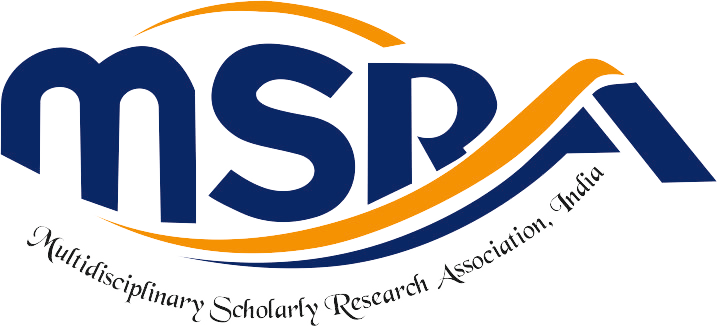Original Research Article
|
Aug. 31, 2024
31 Downloads
DANIAL LERNER YANCHA VIKASAVISHAYAK DRUSHTIKON
Kumar Kambale & Prof. Dr. Omprakash Kalame
DOI : 10.5281/AMIERJ.13593569
Abstract
Certificate
Vikas hi Niranter Suru Rahanari prakriya aahe. Manus aani samajavar sakaratmak parinam ghadavun aananarya balala vikas ase matale jate. Badalachi hi prerana nirman honyasathi samajatargan ghatakanbarobar bahya ghadanari karanibhut tharatat.
Original Research Article
|
Aug. 31, 2024
147 Downloads
EXPLORING THE ROLE OF GAMIFICATION IN ENHANCING STUDENT ENGAGEMENT AND LEARNING OUTCOMES
Anagha Mahajan
DOI : 10.5281/eiirj.13369336
Abstract
Certificate
This paper examines the concept of gamification in education, emphasizing its benefits and challenges through an extensive review of existing literature. Gamification has been increasingly adopted as a pedagogical tool in various educational contexts to enhance student engagement, motivation, and learning outcomes. This review synthesizes findings from multiple studies to provide a comprehensive understanding of the impact of gamification on both students and educators. Additionally, the paper identifies gaps in the current literature and proposes directions for future research.
Original Research Article
|
Aug. 31, 2024
87 Downloads
BUILDING BRIDGES IN EDUCATION: EFFECT OF DIFFERENTIATED INSTRUCTION ON ACADEMIC ACHIEVEMENT
Ms. Latha Murali
DOI : N/A
Abstract
Certificate
Academic Achievement is an effective means of assessing the extent to which students have mastered the concepts taught in a classroom. These tests are usually administered at the end of a teaching learning process to gauge the extent of learning that has taken place after a concept has been taught to the students. It is a means by which the success of a teaching program and the efficiency of the teacher and the process used can be measured. To ensure better academic performance, teachers need to use strategies that cater to differential student needs. Differentiated instruction is one such approach. Whether teachers differentiate content, process, products, or the learning environment, the use of ongoing assessment and flexible grouping makes this a successful approach to instruction. A research was conducted to study the Effect of Differentiated Instructional Strategies on the Academic Achievement of Higher Secondary School students. The paper throws light on the findings of the study and also highlights how differentiated instruction can help improve the academic achievement of diverse students in a classroom.
Original Research Article
|
Aug. 31, 2024
136 Downloads
MAPPING THE LANDSCAPE OF SELF-REGULATED LEARNING: A BIBLIOMETRIC ANALYSIS AND VISUALIZATION OF RESEARCH TRENDS AND PATTERNS
Anagha Arun Mahajan & Dr. Neha Deo
DOI : 10.5281/AMIERJ.13379565
Abstract
Certificate
Self-regulated learning (SRL) plays a crucial role in academic success and lifelong learning. This study aims to conduct a comprehensive bibliometric analysis of SRL research from 2015 to 2022, utilizing data from the Scopus and ProQuest databases. By analyzing 400 articles with tools such as VOSviewer and MS Excel, the study identifies key trends, influential authors, and prominent journals in the field. The results indicate a rising interest in SRL, with a significant increase in publications during 2016. E. Panadero emerged as the most cited author, while Frontiers in Psychology was identified as the leading journal. The study’s co-occurrence analysis highlights core themes, including metacognition, motivation, and educational psychology, offering insights into the evolving landscape of SRL research. These findings underscore the importance of SRL in contemporary educational practices and suggest future research should explore the integration of SRL strategies in diverse educational settings and their impact on student outcomes.
Original Research Article
|
Aug. 31, 2024
89 Downloads
EXPLORING THE IMPACT OF GLOBALIZATION ON IDENTITY, CULTURE, AND HUMAN RELATIONSHIPS IN KIRAN DESAI’S ‘INHERITANCE OF LOSS’
Mr. Munjaji P. Patil
DOI : 10.5281/EIIRJ.13790125
Abstract
Certificate
Kiran Desai is one of the talented and ambitious younger Indian diasporic writers who have a significant role in portraying and reflecting the difficulties and complexities of the experiences of the immigrants in literature. Kiran Desai’s most notable novel, “The Inheritance of Loss” (2006) is set in Kalimpong, which is situated at the foot of mount Kanchenjunga in the North Eastern part of post -Independence India. This novel explores immigration, relationships and identity on both the interpersonal and international scale. Spanning India, England, and the United States, the novel details the conflict between traditional Indian ways of life and the shiny opulence of Western nations. The book won several awards, including the Man Booker Prize in 2006 and the National Book Critics Circle Fiction Award in 2007. Desai wrote the book in the seven years following her 1998 debut, Hullabaloo in the Guava Orchard. The novel highlights some of the outstanding issues of contemporary society such as globalization, marginalization, subordination, economic inequality, exploitation, poverty, nationalism, insurgency, immigration, hybridity, racial discrimination and political violence.To sum up , the novel deals with the conflict of culture , on the global level ; and on the personal level it deals with the internal conflict if identity ( the past and present ). In THE INHERITANCE OF LOSS, Desai tries to capture the pain and dilemma of an immigrant.
Original Research Article
|
Aug. 31, 2024
73 Downloads
ENHANCED CYCLONE INTENSITY PREDICTION: COMBINING DEEP LEARNING WITH DVORAK TECHNIQUE
Ritika Lala, Shirley Maria Horne and Muskaan Shaikh
DOI : 10.5281/EIIRJ.13889931
Abstract
Certificate
With the increasing frequency and severity of cyclonic events, accurate and timely prediction of cyclone intensity is critical for disaster preparedness. This research introduces a deep learning framework for predicting cyclone intensity using satellite imagery. Our approach leverages convolutional neural networks (CNNs) to extract complex features from satellite images, complemented by the Dvorak technique for analyzing eye structure and cloud top temperatures. Additionally, we integrate Decision Tree and Random Forest algorithms to enhance prediction accuracy. Trained on a comprehensive dataset of historical cyclone imagery, our model demonstrates significant improvements in prediction accuracy and efficiency compared to traditional methods. By integrating this deep learning framework into operational forecasting systems, our approach provides enhanced predictive capabilities, supporting more effective preparation and response strategies for regions at risk.




